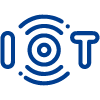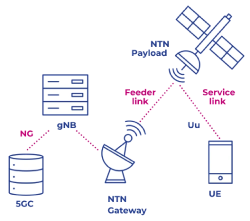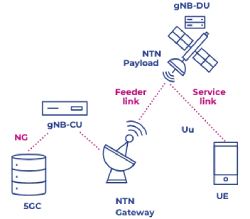- Carrier Grade PHY and L2/L3 Stack Software IPRs for 5G, 4G, NB-loT, 3G
- O-RAN RU IPRs – Low PHY, DUC/DDC, CFR
- Versatile Reference Design – Software Configurable as CU, DU, RU, NIB/RDN
- Deployable Products – Dual Mode 5G/4G Small Cell, NIB/RDN, 5G O-RAN RU, NB-IoT eNodeB
- Focus on Non-Terrestrial Networks and Private Networks – Defence, Public Safety, Mines/Ports
At the forefront of Wireless Innovation, Azcom Technology offers a complete suite of wireless solutions powered by proprietary PHY and L2/L3 Stack Software IPRs, O-RAN RU IPRs, production ready reference designs, able to greatly accelerate the customer’s CU, DU, RU development programs. AII PHY and Stack Software IPRs are available as a stand-alone package or pre-integrated and ported to Azcom’s HW reference platforms. These platforms host baseband and radio hardware, and come along with IP67 compliant mechanical enclosure that permits immediate verification and use of Azcom Solutions, both in lab as well as field environment.
Based around these IPRs and reference designs, Azcom has developed deployable products Dual Mode 5G/4G Small Cells, NB-IoT eNodeB, O-RAN radio, integrated NIB / RDN. These products can be used for providing connectivity solutions for Industrial IoT (Mining, Agriculture, Utilities, Oil & Gas, Logistics), Smart City, Rural, Defence, Public Safety and Mission Critical applications.
Carrier-grade 5G, LTE & NB-loT PHY software conforming to 3GPP & O-RAN specifications
5G High-PHY

- O-RAN 7.2x, 3GPP 8, 7, 6 Split
- FDD, TDD support
- All FR1 Bands support
- Scalable bandwidth up to 100 MHz
- 4×4 MIMO
- FAPI interface
5G Low-PHY

- O-RAN 7.2x Split
- FDD, TDD support
- Cat A and B support
- Up to 32 Antenna
- Full FR1 Sub-Carrier Spacing support
- Scalable bandwidth up to 100 MHz
LTE PHY

- FDD, TDD support
- All Bands support
- Scalable bandwidth up to 20 MHz
- up to 4×4 MIMO
- High Speed Mobility support
- FAPI interface
NB-IoT PHY

- Dual Mode LTE + NB-IoT
- All NB-IoT Bands support
- In-Band and Guard band allocation
- All Coverage enhancement support
- 15KHz & 3.75KHz Sub-Carrier Spacing
- FAPI Interface
Highly Optimized and Scalable 5G, 4G, NB-IoT, 3G Stack Software
5G

- FDD, TDD
- 4×4 MIMO
- IP Data, VoIP, eMBB
- Rich Scheduler type Portfolio
- Seamless mobility support
- CU, DU configurable split
- FAPI/nFAPI Interface
4G

- FDD, TDD
- 4×4 MIMO
- VoLTE, IP Data, VoIP, Mission Critical
- Rich Scheduler type Portfolio
- Seamless mobility support
- FAPI Interface
NB-IoT

- Dual Mode LTE + NB-IoT
- All NB-IoT Bands
- In-Band and Guard band allocation
- NB-IoT Scheduler on top of LTE Scheduler
- C-Plane CIoT EPS Optimisation
- FAPI Interface
NTN Enhancements
- 3GPP R18 Compliant
- Common Baseline Software for NTN and TN Networks
- Support for All NTN-based NG-RAN Architecture
- Flexible Functional Split
- Based on Azcom 5G NR PHY & Stack with NTN Enhancements:
- Multiple Doppler Shift Compensation
- Predictive Channel Estimation
- AMC Tuning to Minimize Retransmissions
- Delay-tolerant RACH and TA Management
- New Scheduling Options for HARQ
- Timers Relationship Adaptation
- Position-aware, Delay-tolerant Scheduler
TRANSPARENT ARCHITECTURE

REGENERATIVE ARCHITECTURE

Azcom Technology provides a set of complete in-house developed building blocks to accelerate customer O-RAN RU development. This O-RAN compliant solution can be easily scaled to support different bands and bandwidths, number of carriers and MIMO. Azcom also provides O-RAN compliant M-plane adaptable to different hardware platforms and C/U/S-plane implementation.
- O-RAN 7.2x compliant Low-PHY
- Category A, Category B RU design
- Configurable carriers’ bandwidth & spatial streams
- Up to 32 Antenna
- TDD/FDD support
- Scalable bandwidth up to 100 MHz
- UL/DL Beamforming on PRBs basis
- Full FR1 Sub-Carrier Spacing support
- Full PRACH Short/Long format support
- DFE Chains (DUC, DDC, CFR, Beam-forming)
- M-RAT Capable
- O-RAN FH M-Plane compliant
DU, RU, gNB Reference Design. Add-on Processor for Core Network and User Applications
- Baseband board hosting processors, FPGA and RFICs
- Pluggable AFE card to support different bands and power outputs
- Integrated power supply
- IP67 compliant mechanical enclosure with antenna interfaces
- Software configurable as 5G/4G&NB-IoT and DU, RU, gNB
- Add-on card processor to run Core, IMS and applications for NIB






